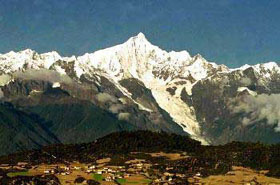| Tools: Save | Print | " target="_blank" class="style1">E-mail | Most Read |
| Shangri-la Looks to Tourism for Reviving Paradise |
| Adjust font size: |
|
The tiny yellow flower is so seductive in bloom. The beauty, however, is a scourge in disguise. When the plant turns fiery red, Shangri-la, a tourist attraction in southwest China's Yunnan Province, harvests a nightmare.
Despite its charming beauty, the plant is known among the locals as "langdu" - literally wolf poison, belonging to the euphorbia fischeriana family. "It's a ferocious killer in disguise. Its appearance signals the degrading of meadows. The degradation, in return, fans its growth because the plant flourishes in dry environs. Hence a vicious cycle is set in motion," warns a botanist of Zhongdian County, now named Shangri-la after the Utopia described by James Hilton in his novel Lost Horizon.
3 rivers flowing abreast
Now, the wonderland is menaced by the unwelcome intruder. Aggressively vigorous, langdu, given space, can adapt to any harsh climate and thrive with its developed root system.
"The plant grows extremely fast in dry years," observes Miao Hengchang, a local shopkeeper, who has witnessed in the past three years the fading charm of the grassland depicted by Hilton in the 1940s as paradise.
"Paradise is in peril with the rampant spread of langdu, mainly as a result of over-grazing," says Qizhala, head of Deqen Tibetan Autonomous Prefecture to which Zhongdian belongs. The prefecture is located in the Sanjiang region, with an area of 40,000 square kilometers.
Ethnic Tibetan official Qizhala says the herdsmen's life has been jeopardized by the degradation of the meadows caused by the invasion of langdu.
Dagiza, a herdsman from Kalzan Village, had to kill a dozen of his new-born lambs because of a lack of feed. "Sheep are the very apple of a herdsman's eye, but I could hardly feed them when grass is insufficient," he says. He still keeps 200 head of cattle, which used to be a symbol of wealth. Now, he sighs, the cattle bring him more worry than joy.
According to village head Tsecheng, a meadow of half or two-thirds of a hectare could support a cow seven or eight years ago. "You now need one full hectare or more to keep things going, as the feeding grass is getting more and more scarce."
Meanwhile, he says, fine meadows are shrinking. "One-third of the natural meadows of the village have deteriorated; and langdu bushes have taken the place of green grass," says Tsecheng.
Meadows degrading
The primary cause for the degradation is overgrazing, says Mo Jiguang, an official with the prefecture's husbandry bureau. "There are too many cattle for the available meadows, which destroy the normal life cycles of feeding grass. This paves the way for the langdu, whose fast growth makes it hard for the meadows to recover."
According to the prefecture's husbandry bureau, the natural meadows throughout the prefecture are good enough to support 290,000 head of cattle at most, whereas the actual cattle population has reached 390,000.
Qizhala admits that there is a lack of effective control on herd sizes; while among the herdsmen, there is a blind faith in the big size of cattle as a symbol of wealth.
However, the local government and people are determined to save their natural meadows and preserve the charm of the unique landscape of Shangri-la.
After trying several means, they have come to realize that the best solution lies in leaving the natural grassland intact. "Mother Nature's ability to restore bio-diversity is amazing," says Qi Yaodong, an ecologist with the Botany Institute of the Chinese Academy of Sciences, who has been studying the situation in Deqen for years. "Tests have proved that given a period of time for recuperation, degraded meadows would take a turn for the better, with good grass overgrowing the bad one and ecological balance restored."
Recuperation project
A rehabilitation project to let grazing give way to natural grass growing has been launched in Deqen, with a total input of 22 million yuan (US$2.5 million). In 2003, 106,700 hectares of meadows, 17.8 percent of the total 601,000 hectares, were restored, of which 26,700 hectares are completely banned for grazing, 46,700 hectares are to lie fallow, and the rest for rotational grazing.
A more fundamental countermeasure to check the deterioration of the region's environment, says Qizhala, is to restructure the prefecture's economy, which used to rely on logging up to 1998. "Then husbandry became the backbone of our economy."
Now the local officials eye tourism as a new alternative for economic growth. In 2002, Deqen received 1.5 million tourists, 23 percent more than the previous year, raising profit by 52 percent. The arrivals in 2003 are expected to have surpassed the 2002 figure.
The thriving tourism industry has benefited local herdsmen, as some 300 households get an average of 1,000 yuan each taking tourists to attractions on horseback.
Again, there is the challenge to keep a balance between ecological preservation and tourism. "The local government should see to it that the environment is not overloaded," says Chen Jie, an official with the Nature Conservancy, a US-based organization. "In such a fragile environment as the Sanjiang region, any serious damage would be irreversible."
Surely Qizhala knows this. And he has other pressures. To date, there are still 60,000 people, 24 percent of the population in the prefecture, living below the poverty line. Development is top on his agenda.
"The problem is how to boost development in such a region at the minimum cost of resources," he says, adding "in comparison, tourism industry costs less and benefits more, and is thus regarded as a good replacement for husbandry."
(China Daily February 13, 2004) |
| Tools: Save | Print | " target="_blank" class="style1">E-mail | Most Read |
 |
| Related Stories |


